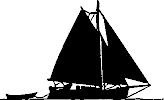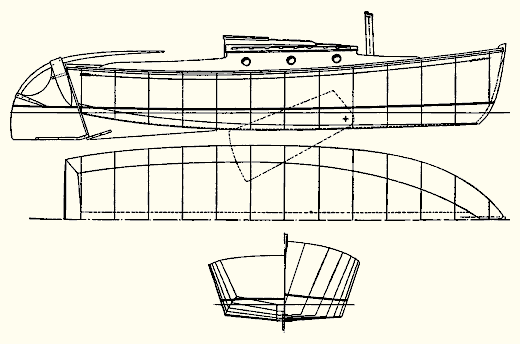
| Jaquelin A 21' 6 1/2" Skipjack Cruising Knockabout By William & John Atkin |
| A 20-Foot Skipjack | |
| Here we have the designs of a skipjack that will measure 21 feet 6 1/2 inches in overall length; 20 feet on the water line; 7 feet 6 inches in breadth; with a draft of 1 foot 4 inches. The freeboard at the bow is 3 feet 2 inches; at the lowest place, 2 feet; and at the stem, 2 feet 3 1/2 inches. Jaquelin is knockabout rigged, staysail and main, and has a sail spread of 243 square feet; 57 square feet in the staysail which, by the way has small overlap; and 186 square feet in the mainsail. I would stow about 500 pounds of lead ballast each side the keel between stations 3 and 9; 1,000 pounds in all. | |

| |
| The deck plan shows a forward deck 7 feet 2 1/2 inches long; deck house 6 feet 5 inches long; bridge deck 1 foot 6 inches long; cockpit 3 foot 6 inches long and after deck 2 feet 11 inches. The cockpit is approximately 5 feet 6 inches in width. The well floor is 9 inches above the load water line and will be self-draining. The deckhouse is low with an average width of 5 feet 3 inches; this leaves a waist deck somewhat over a foot wide each side and 17 inches wide at the forward end of the house. | |

| |
| The cabin plan shows work tables each side aft, these to be used for a single-burner alcohol stove, lockers, sink, dishes, and other house-keeping equipment. There is a seat each side abreast the centerboard trunk. With swing tables each side the trunk in good old cat-boat style, two persons can have the nicest little snug cabin one might ask for. And then forward there is a big bunk wide enough for two. The headroom under the companion way slide is 4 feet 3 inches and under the top carlins slightly less than 4 feet. There will be the temptation to raise the line of the sheer and the height of the deckhouse. I would not advise either change. In the first place the appearance of the boat will be ruined and the sailing ability destroyed. If more room is needed build a different kind of boat. | |

| |
The lines show a hull having throughout its length straight sections; the topsides have generous flare from bow to stern. Plenty of flare in the topsides of any skiff or skipjack is a sure indication of stability under sail or at rest. The chines and the rabbet have a common beginning at the heel of the stem and gradually diverge in easy sweeps to the stern at which point they are about 5 inches apart. Thus the deadrise increases from bow to stern. The advantages of this are: there is a nice tuck-up in the after buttock lines permitting easy water flow along the bottom when the boat is heeled down; the bottom is very easy to frame and plank because there are no violent twists to overcome; there are no acute angles forward at the chine corners; and the side planking can overlap the edge of the bottom strakes of planking thus covering all the "jib-ends" of the latter where they run out into the chines. And so we have the little skipjack Jaquelin in MoToR BoatinG's family of boats. And an excellent kind of boat it is, too, wholesome, simple, easy to build, inexpensive and full of character. | |
| Plans for Jaquelin are $100 MYSTIC SEAPORT MUSEUM SHIPS PLANS STORE https://store.mysticseaport.org/ships-plans/ shipsplanstore@mysticseaport.org
+1 (860) 572 5360 | |
| BACK TO PLAN LIST | |